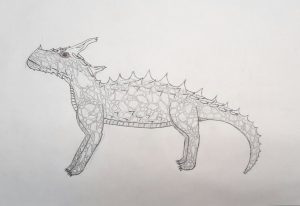So over the school holidays I had an assignment for my Big History elective (it’s a university course but I my high school does a simpler version). It was just amazing, the best assignment I’ve ever had, 10/10 would do again. And I thought I’d share it so anyone could use it as a guide to create their own species in their stories.
Big History is a course that teaches science and history and things like that to tell an overview of how our world came to where it is and where we’re going next through thresholds (there’s a great site called the big history project, which you can sign up to for free). The main thresholds are the big bang, then stars light up, new chemical elements, earth and the solar system, life, collective learning, agriculture, the modern revolution, and the future. We’d been doing life, and our assignment was to come up with an animal/plant and figure out its taxonomy, anatomy, habitat etc. and make sure it was completely scientifically possible. We were supposed to do this in groups but were allowed to work alone if we liked — I chose to go alone, being an introvert and I already had a great idea that I wasn’t going to let anyone ruin.
The Assignment:
There were two parts to this assignment we were given: the presentation and the individual research journal. Some of the research journal things don’t matter for actually creating the animal, and depending on your world you’d also have to add thing to figure out for your species. The following are the most important points, but feel free to adapt it to your needs and world’s circumstances.
Things to include when creating a species:
- name of the plant/animal and its taxonomy (classification) including a scientific name that follows logical naming conventions
- who, when, and how it was discovered
- its habitat and environment and, if it’s extinct, what time period it lived in
- what it looks like, possibly including a drawing
- how does it reproduce? Eggs or live young, how many and how often? Seeds or spores? (Stay consistent and explain exceptions)
- what/how does it eat? Carnivore/omnivore/herbivore/photosynthesis/other?
- does it have competition or enemies?
- how does it protect itself/what are the consequences of being fragile?
- (if it’s an animal) does it hibernate or migrate? (if it’s a plant) Is it deciduous or perennial?
- how has it evolved to suit the habitat/ecosystem in which it lives/lived? You can create a tree/chart to show the developments
- what impacts it has on humanity (or other main creatures that run your world), and what impact humanity (again, or other creatures) has on it
- (if your world has magic) does it have magic? If so, how does it control or use it? (other magic rules such as ‘what effort using magic takes’ apply here)
Some Basic Info on My Species:
The animal I created is called the True Desert Drake, and it evolved from the Red European Dragon. The True Desert Drake only lives in the Great Sandy Desert in WA, among the spinifex grasses, and it likes to dig into the sand to hide.

Drakes have two glands in the back of their throat that makes a liquid that ignites when it comes into contact with the air. Its mouth is protected by mucus, and pores in the skin also produce this mucus, protecting the Drake through the leidenfrost effect. The True Desert Drake uses its fire ability to protect itself and attack rivals or predators.
I’m planning to adapt it from our world to fit in one of my future stories, so keep an eye out!
I also came up with a creature , an alraune which looks like a green girl attached to a flower but when she opens her mouth her body splits into jaws of an enormous dragon, it evolved from the rong (Vietnamese dragon) it was first discovered by a US soldier in 1965 during the Vietnam war who thought it was a nymph
That’s really cool! Do you have a picture?